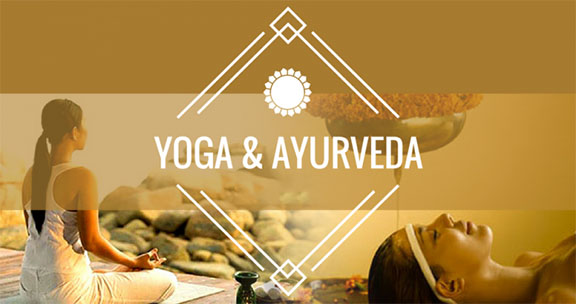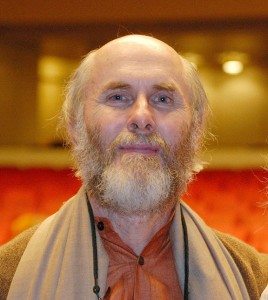 Dr. David Frawley is regarded as one of the world’s foremost experts on Ayurveda, Yoga. and Vedic Studies. In this article, he discusses how the eight limbs of Yoga can be used for healing both body and mind in a complete and integrated Yoga and Ayurveda Therapy system.
Dr. David Frawley is regarded as one of the world’s foremost experts on Ayurveda, Yoga. and Vedic Studies. In this article, he discusses how the eight limbs of Yoga can be used for healing both body and mind in a complete and integrated Yoga and Ayurveda Therapy system.
Yama and niyama form the ideal dharmic practices and principles for spiritual practice and for healing. Ahimsa (nonviolence) and the other yamas and niyamas counter negative attitudes that damage the mind and emotions. For example, the thought of harming others or wishing negativity on others, disturbs our own psychology by sending negative energies to other people. Asana practice balances the body, particularly vata dosha. We need an asana practice in order to stabilize and relax the body. It’s not about creating stress to hold the posture, rather, it’s about relaxing into the posture. This helps us to develop a similar peaceful attitude in our daily life.
Prana is the basis of all the doshas (three life forces or energies comprised of universal elements. Vata, wind; pitta, fire, and kapha, water). Pranayama allows us to develop more prana for healing or for higher awareness. With asana you are working indirectly on the doshas through the musculoskeletal system. Asana is something you do and so it can be done in various ways. There is not just one asana for any of the doshas. How one does the asana is equally important as the form of the asana. However, pranayama can be more specifically used for heating or cooling, expanding or contracting and balancing the doshas. Pranayama is a central focus in Ayurvedic healing and can be used for physical as well as psychological problems.
Yet while increasing prana can be used to develop energy, without the process of internalizing the prana and developing sattva, that energy may not be healing or spiritually transformative in nature. Pratyahara is the step in which we begin to internalize the prana which is necessary for healing as well as for meditation. Many therapies such as massage and other forms of bodywork introduce prana by placing the patient in the mode of rest. The patient then enters into a receptive mode where their prana can be used for healing. The therapist actually is preparing the patient to move the prana back in.
In our culture today, we see many people facing problems that essentially arise from issues developing from sensory overload. We are literally bombarded with millions of stimuli every moment of our lives. What junk food does to the body, junk impressions do to the mind. We need to learn how to manage the senses, which is the essence of pratyahara, so we are not creating toxicity at a sensory level. This fifth limb of Patanjali’s Ashtanga Yoga is so important because it helps train us to withdraw our senses from the negative impressions and cultivate positive ones. Through the practice of pratyahara, we can also learn to connect to the inner sound and inner light and other higher forms of impressions.
Healing is not just a matter of what we do, but is often a matter of doing less. Yoga therapy is not necessarily about adding another therapy, another thing or more stress to further deplete our already depleted energy. Pratyahara is about learning to give proper rest to the nervous system. Our nervous system has been so stimulated that it doesn’t have time to shut down and we don’t get proper rest or sleep-even the ability of the mind and prana to rest gets lost. If we try to meditate without first practicing pratyahara, what happens is that, because the senses are over-stimulated, when we sit and close our eyes, the senses express as sensory overload and pranic disturbances-we become besieged by the inability to sit still, turbulent waves in the mind and other disturbances. Without pratyahara, we don’t have the necessary energy for physical healing or spiritual growth. Pratyahara is like sealing the vessel-otherwise if you try and gather water utilizing a vessel with holes, you don’t get very much water and that is what meditation can become.
The remaining eight-limbs of Yoga rest upon developing the power of attention, which is working with our inner focus. A lot of dharana practice consists of drishti, or fixing the gaze. The point of focus can be internal or external. Focusing the mind’s eye aids in concentration. A big problem in our culture, especially in children, is a short attention span. The model for the American movie is the comic book-one action scene after the other. You have 20 seconds per frame to hold people’s attention and if you lose that, it’s hasta la vista baby! [Laughs] Because of that, people don’t have the power of attention anymore. We are so used to being stimulated that we have become dependent upon outer stimuli for our sense of well-being. Yet over time, you can reach a threshold and then stimuli will no longer work. Sensory enjoyment needs to be novel and after a while the usual stimulus fails to excite us. So you have to make sensation stronger and stronger. If all we are after is stimulation, then there’s no love, there’s only sensation. Love has the power to renew, but sensation doesn’t and this is what leads to all kinds of obsession and compulsion. Another psychological issue is that because we are so dependent on an external stimulus for our motivation, that when that stimulus is withdrawn, depression usually ensues.
We are seeing a lot of Attention Deficit Disorder (ADD) problems in children and also adults. Kids are immediately placed on ADD drugs when really we should be helping them develop the power of attention. If we use drugs, all we are doing is moving them from rajas to tamas, from over-stimulation to a state of dullness. Another aspect of having no power of attention is that without that, you don’t have the power of judgment. If my attention changes every few seconds with the external stimuli it is chasing, how can I make a decision of what is good and bad or right and wrong? To really think critically about something, you need sustained attention. The power of attention is like a muscle and if not worked, it atrophies.
When you have the power of attention, then you can begin to meditate, to hold the attention on something and reflect upon it. This is the seventh limb of dhyana. Meditation has a therapeutic aspect-when the mind is in an empty state, it has the power to heal itself. Like fasting from food is for the body, meditation is similarly healing for the mind. When the mind is held in an empty or receptive state it is not caught up in its own conditioning and it can heal itself. In this regard deep meditation is similar in healing power to the state of deep sleep..
Nowadays, we use the term “meditation” loosely. But, classically, meditation is balance, silence, full concentration, internalization. Meditation without a foundation of pranayama, pratyahara and dharana may not be real meditation. If you sit to meditate with your state of mind disturbed and rajasic, you may just sustain that energy of rajas and sink further in your own thoughts. So, real meditation rests upon preparatory practices to aid us in getting back to our original nature of sattva. Otherwise, we are just reflecting, rather than moving beyond our samskaras. The samskaras are the basis of the kleshas, which are the basis of suffering. The fire of inner knowledge can burn up the samskaras once we have cultivated that flame of meditation.
The last step in Ashtanga Yoga is samadhi. This is when the mind is able to merge into the object of contemplation. The mind has its conditioning that serves as a screen between us and what we see. In samadhi, that screen is removed and the mind reflects the reality that is. This is a product of sustained attention. When that becomes the natural state of mind, it can reveal the essence of whatever it examines. This is the state of “Sat” or pure being of Vedanta. It is the Buddhist principle of “seeing things as they are, without anything added.”
There is also a point in Ayurveda and Yoga where we go beyond physical and psychological healing. The goal of Ayurvedic therapy and psychology is to create sattva guna. But, moksha [liberation] is beyond any physical or psychological condition. It is purely a spiritual goal. That is ultimately the aim of all Yoga. Meditation is a tool for healing or spiritual practice but it is not itself the goal. So, we must necessarily ask the question, “What is it that we are meditating on?” Meditation will give us deeper knowledge in many ways, but it is only meditation on the Atma, or true Self that brings about liberation.
Going beyond the mind and body is the deeper sadhana and practice of Yoga. The goal of the Yoga Sutras is not simply sattva guna or an harmonious body and mind. Developing sattva guna is the foundation of our practice but not its culmination. From a state of psychological well-being, we want to go beyond the sphere of the mind altogether to that of pure consciousness. The true goal of Ashtanga Yoga is the permanent end to all suffering of body and mind. Suffering is inherent in the body and mind. We can’t get beyond all suffering unless we can place our consciousness beyond the body and mind. The simplest way to do this is to return to the witness consciousness within us. This is our natural connection to the Self beyond the gunas. Our goal in Yoga is to be one with that consciousness beyond the dualities. This is moksha.
 Dr. Frawley (Vamadeva Sastri) is Founder and Director of the American Institute of Vedic Studies and the author of thirty books, several training courses and over a hundred articles on Vedic systems of knowledge. He has taught extensively in the U.S. and Europe and is highly regarded in India as a Vedic teacher. For more information on Dr. Frawley’s courses and publications, please visit: www.vedanet.com.
Dr. Frawley (Vamadeva Sastri) is Founder and Director of the American Institute of Vedic Studies and the author of thirty books, several training courses and over a hundred articles on Vedic systems of knowledge. He has taught extensively in the U.S. and Europe and is highly regarded in India as a Vedic teacher. For more information on Dr. Frawley’s courses and publications, please visit: www.vedanet.com.

